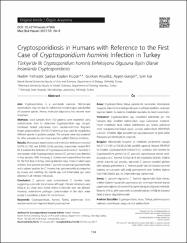| dc.contributor.author | Yılmazer, Nadim | |
| dc.contributor.author | Kaplan Küçük, Şadiye | |
| dc.contributor.author | Akyıldız, Gürkan | |
| dc.contributor.author | Gargılı, Ayşen | |
| dc.contributor.author | Kar, Sırrı | |
| dc.date.accessioned | 2022-05-11T14:28:36Z | |
| dc.date.available | 2022-05-11T14:28:36Z | |
| dc.date.issued | 2017 | |
| dc.identifier.issn | 1302-0072 | |
| dc.identifier.issn | 2147-2688 | |
| dc.identifier.uri | https://doi.org/10.4274/haseki.47966 | |
| dc.identifier.uri | https://hdl.handle.net/20.500.11776/6886 | |
| dc.description.abstract | Aim: Cryptosporidiosis is a worldwide zoonosis. Microscopic examinations may fail due to indistinctive morphological peculiarities of causative species. Hence, molecular diagnostics has become more important. Methods: Stool samples from 150 patients were examined using carbol-fuchsin stain to determine Cryptosporidium spp. oocysts. Combined nested polymerase chain reaction-restriction fragment length polymorphism (PCR-RFLP) technique was used for establishing different species in positive samples. The samples were also screened for other parasites by wet-mount and zinc sulfate flotation methods. Results: Microscopic examinations and molecular techniques revealed 0.67% (1/150) and 8.93% (5/56) positivity, respectively. Nested PCR-RFLP enabled the detection of Cryptosporidium hominis (C. hominis) in one sample, while Cryptosporidium parvum (C. parvum) was detected in four samples. With this study, C. hominis was reported from humans for the first time in Turkey. Among infected ones, three of which were children, four patients excreted C. parvum oocysts had gastroenteritis, and a patient positive for C. hominis had gastroenteritis accompanied by nausea and vomiting. No Giardia spp. and Entamoeba spp. were detected in all infected individuals. Conclusion: C. parvum cases outnumbered C. hominis cases, suggesting a zoonotic transmission although infected individuals were living in an urban area where animal husbandry was not allowed. However, water-borne pathogen contamination in the city's water supply is considered a factor for transmission. | en_US |
| dc.language.iso | eng | en_US |
| dc.publisher | Galenos Yayincilik | en_US |
| dc.identifier.doi | 10.4274/haseki.47966 | |
| dc.rights | info:eu-repo/semantics/openAccess | en_US |
| dc.subject | Cryptosporidiosis | en_US |
| dc.subject | human | en_US |
| dc.subject | Turkey | en_US |
| dc.subject | polymerase chain reaction-restriction fragment length polymorphism | en_US |
| dc.subject | Prevalence | en_US |
| dc.subject | Spp. | en_US |
| dc.subject | Calves | en_US |
| dc.subject | Diagnosis | en_US |
| dc.subject | Subtypes | en_US |
| dc.subject | Parvum | en_US |
| dc.title | Cryptosporidiosis in Humans with Reference to the First Case of Cryptosporidium hominis Infection in Turkey | en_US |
| dc.title.alternative | Türkiye'de ilk Cryptosporidium hominis enfeksiyonu olgusuna ilişkin olarak insanlarda Cryptosporidiosis] | en_US |
| dc.type | article | en_US |
| dc.relation.ispartof | Haseki Tip Bulteni-Medical Bulletin of Haseki | en_US |
| dc.department | Fakülteler, Fen Edebiyat Fakültesi, Biyoloji Bölümü | en_US |
| dc.authorid | 0000-0002-8610-5174 | |
| dc.identifier.volume | 55 | en_US |
| dc.identifier.issue | 3 | en_US |
| dc.identifier.startpage | 194 | en_US |
| dc.identifier.endpage | 198 | en_US |
| dc.institutionauthor | Yılmazer, Nadim | |
| dc.institutionauthor | Akyıldız, Gürkan | |
| dc.institutionauthor | Kar, Sırrı | |
| dc.relation.publicationcategory | Makale - Uluslararası Hakemli Dergi - Kurum Öğretim Elemanı | en_US |
| dc.authorscopusid | 6505825773 | |
| dc.authorscopusid | 52563817200 | |
| dc.authorscopusid | 56543627500 | |
| dc.authorscopusid | 55982960800 | |
| dc.authorscopusid | 15769247000 | |
| dc.authorwosid | Gargili, Aysen/AAE-7171-2019 | |
| dc.authorwosid | Akyildiz, Gurkan/AAE-8609-2019 | |
| dc.identifier.wos | WOS:000423909700005 | en_US |
| dc.identifier.scopus | 2-s2.0-85031751262 | en_US |



















